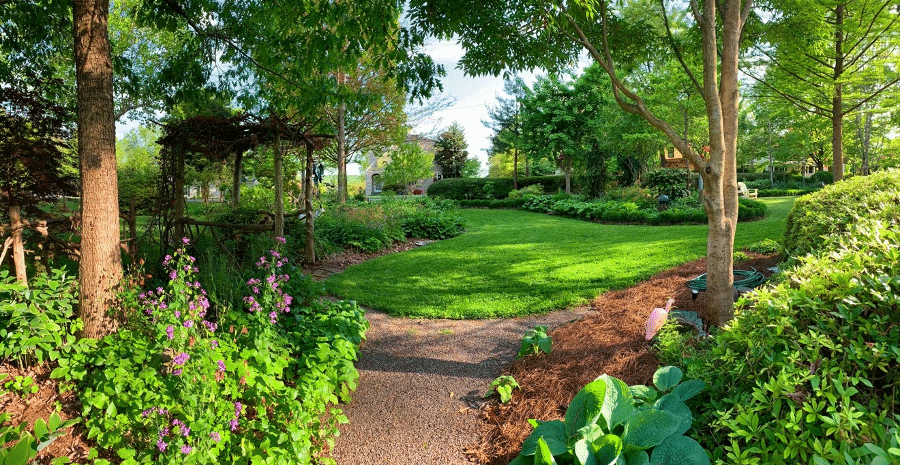Gardening along property lines

A typical suburban property line. Yawn.
I’ve heard it said before that everyone has two property lines. There’s the one you own and the one you mow. It’s very hard to argue the fact that we are a territorial species. There exists at least one guy in every subdivision who has perfected the technique of lawn fertilization. We’ll call him “Green Man”. Green Man doesn’t use a cyclone-type spreader to keep his lawn lush. He carefully guides a drop spreader along his property line and applies just the right amount of lawn food to make his yard glow like a leprechaun on St. Paddy’s Day while his neighbor’s lawn looks sick by comparison.
There is a better way to look at the landscape along property lines and it can be summed up in one word, collaboration. I not only feel that there is way too much mown turf in the American landscape but there is also a lack of imagination on how to landscape along borders.
DON’T GIVE IT AWAY
Aside from the standard landscaping along the front foundation, the plantings in many suburban landscapes look very similar. We tend to place a “decorative” tree or two (decorative meaning flowering and short-lived vs. legacy trees meaning they will outlast you and possibly your grandchildren) in the front yard and plant some token shrubs or flowers beneath. You’ve no doubt seen these kidney bean beds. It’s not so much the shape of these islands that bugs me but the way they appear to visually give away part of the yard to the neighbor. A viewer’s eyes will take in these plantings and the space between them and the house as being one landscape and see the area behind these beds to the property line as being another. When I design, I have a tendency to define a pleasing shape of lawn and then concentrate heavy plantings nearer the perimeter. This method maximizes the use of space and doesn’t visually give away any property. Keep this in mind, often the shape of the lawn is more important than the shape of the beds.

Landscaping for privacy can provide a feeling of protected enclosure. Be careful though to make such screening in line with the human scale.
AWKWARD ANGLES
I know what you’re saying. That’s all well and good but having beds that abruptly stop at the property line aren’t any friendlier than Green-man’s fertilization practices. You’re right and this leads to the heart of this article. Rather than have beautifully curved beds slam into the property line resulting in some often very awkward angles, talk to your neighbor about collaborating on some planting schemes. Ideally some of the same species being used on both lots will help to blur the separation. As we tend to layer our foundation plant material based on height (shorter in the front, taller toward the back) this same graduation of height may also work on these shared beds. I say “may” work because most of us desire more privacy in our backyards in which case the ultimate plant height will be taller than the border plantings in the front yard where privacy may not be as crucial.

A view of our front/side garden. Notice the arbor connecting our property to a very fine neighbor. (Having great neighbors increases the desire for connectivity).
“Good fences make good neighbors”. The same is true with regard to planting design. I am very fortunate to have some great neighbors. I hope many of you have the same situation. If you do you will need to think about access, that is how can you travel next door to borrow say an anvil without having to walk out to the street and then up your neighbor’s drive or walk to get there. Simple stepping stones or a short, crushed stone path will usually do the trick. I have actually built an arbor between my yard and my neighbor / dentist’s property (he knows a lot more about perennials than I do by the way). Being able to move comfortably between spaces is crucial in any landscape design. What if you don’t quite get along with your neighbor? Plant for versatility. One day some folks you really enjoy may move into that house in which case hopefully both of you will want a shortcut to next door.

My illustration of what “blurring the boundary” may look like.

Here is a Google spy shot of our house (left) and neighbor. Notice how the planting along the property line benefits both sides.
An interesting thing happens when enough folks in your community start designing their properties as I have described here. You will begin to enjoy the benefits of miniature wildlife corridors. The disappearance of so many little critters and birds in suburbia is attributed to the destruction of habitat (and cats). By recreating green “ribbons” throughout your neighborhood you will not only provide the shelter these creatures need but will also have created safe zones in which they may travel without being threatened by mowers, weed whackers, or other destructive noise-makers. Neighboring landscapes can be both beautiful and ecologically beneficial. I feel the same way about diverse plantings as I do about cheese, the more the merrier. Now go and talk to your neighbor.
Till next time,
BLUR THAT BOUNDARY AND GET TO KNOW YOUR NEIGHBOR
Please share and subscribe! https://ahomeforyourgnome.com/

